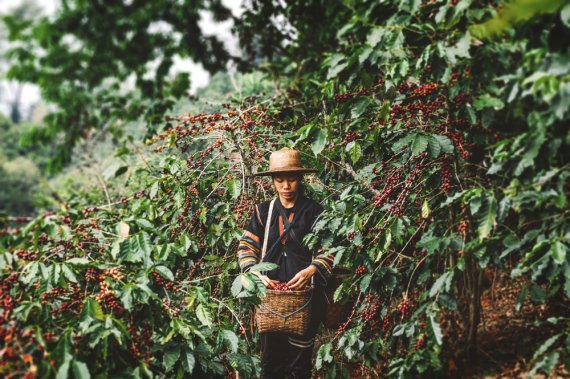Over half the coffee acreage in the Atlantic coastal zone in Brazil will be unsuitable for coffee cultivation in 2050, De Carvalho Gomes concludes based on model research. He assumes that the temperature in the region will rise by two degrees as a result of climate change. The Arabica strain is particularly sensitive to such temperatures. Agroforestry, planting trees on coffee plantations, will provide the coffee plants with shade, allowing three-quarters of the current coffee cultivation to be preserved in the Atlantic coastal area. Thus concluded the Brazilian PhD candidate, who obtained his degree in Wageningen last week.
Agroforestry
This conclusion is not new. An international team of scientists, which includes Wageningen Milena Holmgren Urba, presented a study in 2019 on agroforestry in coffee cultivation. They recommended farmers plant fruit-bearing trees, such as cocoa plants, on coffee plantations, as these trees resist drought and higher temperatures.
While most coffee plantations in Brazil are monocultures, the international study with Holmgren Urba focuses on Central America, where coffee is traditionally grown in agroforestry systems. However, even in these systems, the Arabica plant suffers from climate change, Holmgren clarifies, mainly because unstable weather leads to an increase in diseases. Thus, some 70 per cent of the coffee plants in Central America is affected by the coffee leaf rust disease.
Replacement
The international study, in which the World Agroforestry Centre is involved, recommends an adjustment of the current agroforestry systems. A partial replacement of coffee plants with cocoa plants is one such recommendation. Furthermore, mango, guava and avocado trees, all of which exist in these food-forests, also appear to be affected by climate change. Replacing some of these trees with climate-proof fruit trees will allow food-forests to adapt to the climate.
Soil scientists
But, even this is not the first WUR study on the value of agroforestry in Latin-American coffee production. In 2012, Wageningen soil scientists Ron de Goede, Mirjam Pulleman and Lijbert Brussaard collaborated with Brazilian colleagues to research the effect of agroforestry on coffee cultivation in the Atlantic rainforest in Brazil. They compared eight food-forests with coffee plants, mainly small, family-owned farms, with four monocultures where the coffee plants were located in the sun. In this study, 230 different tree species were found in the food-forests, almost all indigenous. The soil temperature in the food-forests averaged 6 degrees lower than that of the monocultures. Their conclusion was: agroforestry serves both coffee production and biodiversity during climate change.
Altitude
De Carvalho Gomes now narrows down this conclusion even further. He states that it is already too warm to grow coffee in the coastal area below an altitude of 600 metres. Moreover, he says that in 2050, coffee cultivation in monocultures will only be possible at an altitude of over 800 metres. A shift to higher grounds would cause conflicts between coffee farmers and nature conservationists, as many nature reserves in the Brazilian coastal area are located above 800 metres.

 Photo: Shutterstock
Photo: Shutterstock